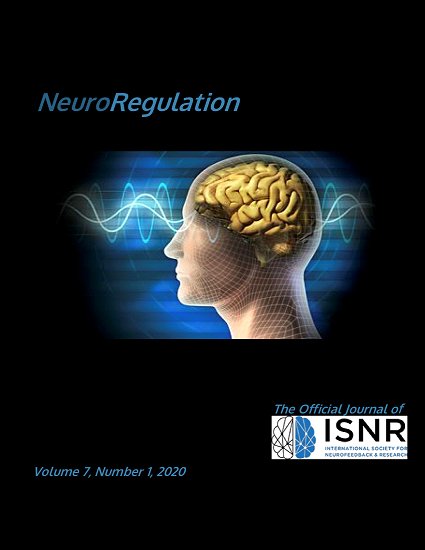Principles and Statistics of Individualized Live and Static Z-Scores
DOI:
https://doi.org/10.15540/nr.7.1.45Keywords:
eeg, qeeg, statistics, database, z-scoresAbstract
This report describes and briefly characterizes a method for computing quantitative EEG (qEEG) z-scores based on a modification of the typical methods used for qEEG reporting. In particular, it describes using a sample of EEG from a single individual, and creating a reference database from the individual sample, in contrast to using
a population of individuals as the source data. The goal of this method is to quantify and localize within-subject changes that may arise due to time or various factors. We refer to this approach as “z-builder,” because the z-score reference is constructed or “built” on a per-subject basis in the office or laboratory and is not derived from a reference obtained from an outside source. It is confirmed that z-scores for EEG acquired during a test period can be calculated based on a single previously recorded reference sample from an individual, and that the resulting z-scores obey the expected statistical distribution. Reference data can be calculated using samples in the 1- to 5-minute range, and subsequent static or dynamic z-scores for a test sample can then be computed using this reference data in lieu of a population database. It is confirmed that, in the absence of systematic change in the EEG, z-scores generally fall well within the range of ±1.0, providing a sensitive indicator when
changes do occur. It is shown that this method has value in assessing individual stability of EEG parameters and for quantifying changes that may occur due to time effects, aging, disorders, medications, or interventions.
References
Collura, T. F. (2014). Technical Foundations of Neurofeedback. New York, NY: Routledge.
Collura, T. F. (2014, Spring). Specifying and developing references for live z-score neurofeedback. NeuroConnections, 26–39. Retrieved from https://docs.wixstatic.com/ugd/cba323_b824c922625941808b2d633bc63f3df7.pdf
Collura, T. F. (1990). Real-time filtering for the estimation of steady-state visual evoked potentials. IEEE Transactions on Biomedical Engineering, 37(6), 650–652. Accessed from https://www.ncbi.nlm.nih.gov/pubmed/2354847
Collura, T. F., Thatcher, R. W., Smith, M. L., Lambos, W. A., & C. R. Stark (2009). EEG Biofeedback training using live Z-scores and a normative database. In J. R. Evans, T. H. Budzynski, H. K. Budzynski., & A. Arbanal (Eds.), Introduction to quantitative EEG and neurofeedback: Advanced theory and applications, Second Edition (pp. 103–142). New York, NY: Elsevier.
Host-Mandel, A., & Handel, P. (2000). Effects of sampling and quantization on single-tone frequency estimation. IEEE Transactions on Signal Processing, 48(3), 650–662. Accessed from http://www-ee.eng.hawaii.edu/~madsen/papers/48sp03-hostmadsen.pdf
Kerson, C., deBeus, R., Lightstone, H., Arnold, L. E., Barterian, J., Pan, X., & Monastra, V. (2020). EEG theta/beta ratio calculations differ between various EEG neurofeedback and assessment software packages: Clinical interpretation. Clinical EEG and Neuroscience, 51(2), 114–120. https://doi.org/10.1177/1550059419888320
Messick, S. (1998). Test validity: A matter of consequence. Social Indicators Research, 45(1–3), 35–44.
Miller, J. N., & Miller, J. C. (2018). Statistics of repeated measures. In J. N. Miller & J. C. Miller (Eds.), Statistics and chemometrics for analytical chemistry (6th ed., pp. 17–26). Harlow, England: Pearson. Retrieved from https://manualzz.com/doc/27792868/statistics-and-chemometrics-for-analytical-chemistry
Siever, D., & Collura, T. (2017). Chapter3 – Audio-visual entrainment: Physiological mechanisms and clinical outcomes. In J. R. Evans & R. P. Turner (Eds.), Rhythmic stimulation in neuromodulation (pp.51–95). New York, NY: Elsevier.
Social Science Statistics (2019). T Test Calculator for 2 Dependent Means. Retrieved from https://www.socscistatistics.com/tests/ttestdependent/default.aspx
Thatcher, R. W. (2008, April). Z-Score EEG biofeedback conceptual foundations. NeuroConnections, 9–11. Retrieved from https://docs.wixstatic.com/ugd/cba323_426c6449511f48968c49c4ee94fa0c7e.pdf
Downloads
Published
Issue
Section
License
Authors who publish with this journal agree to the following terms:- Authors retain copyright and grant the journal right of first publication with the work simultaneously licensed under a Creative Commons Attribution License (CC-BY) that allows others to share the work with an acknowledgement of the work's authorship and initial publication in this journal.
- Authors are able to enter into separate, additional contractual arrangements for the non-exclusive distribution of the journal's published version of the work (e.g., post it to an institutional repository or publish it in a book), with an acknowledgement of its initial publication in this journal.
- Authors are permitted and encouraged to post their work online (e.g., in institutional repositories or on their website) prior to and during the submission process, as it can lead to productive exchanges, as well as earlier and greater citation of published work (See The Effect of Open Access).











